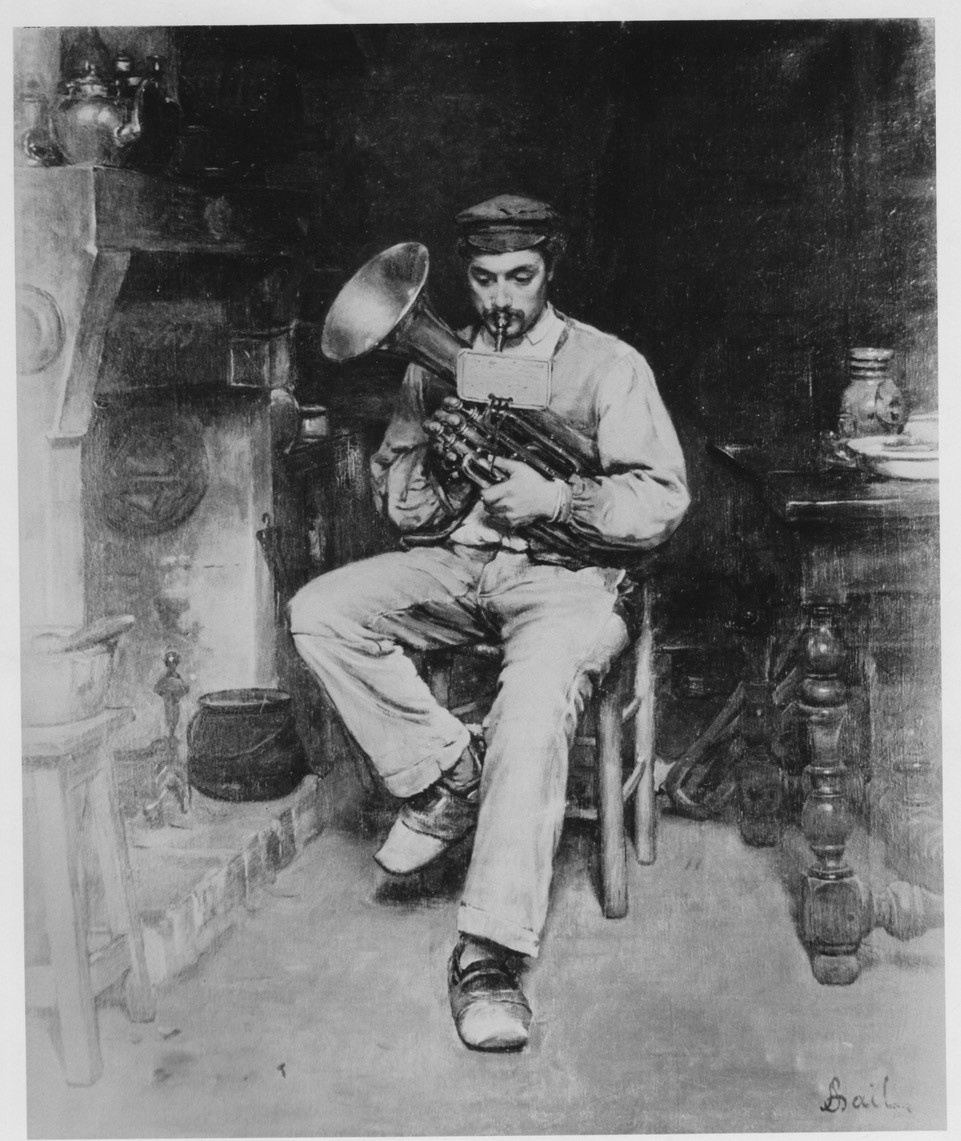
13. Antoine-Jean Bail, The Cornet
| Artist | Antoine-Jean Bail, French, Chasselay, Rhône 1830–Nesles-la-Vallée, Val-d’Oise 1919 |
| Title, Date | The Cornet (Le cornet à pistons), c. 1880 |
| Medium | Oil on wood panel |
| Dimensions | 13 3/4 × 10 7/16 in. (35 × 26.5 cm) |
| Inscriptions + Marks | Lower right: A Bail |
| Provenance | [L’Horizon Chimérique, Bordeaux, France, until 2019; to Weisberg]; Yvonne and Gabriel Weisberg, Minneapolis |
| Exhibition History | "Reflections on Reality: Drawings and Paintings from the Weisberg Collection," Mia, 2022–23 |
| Credit Line | Promised gift of Gabriel P. and Yvonne M.L. Weisberg, Minneapolis |
Antoine-Jean Bail undoubtedly encountered this cornet player during summer holidays in Bois-le-Roi, a small town about twenty miles southeast of Paris, near the forest of Fontainebleau.1 He probably met him through his friend Olivier Métra (1830–1889), a composer who started a local band, or fanfare, in 1879. Known as the Fanfare de Bois-le-Roi, it was mostly a brass band that played outdoor concerts for fellow villagers. The cap worn by this horn player was part of the musicians’ uniform. Bail varied his brushwork here depending on how much specificity he wanted. The horn is described in detail, while the man’s pants are freely rendered in broad, quick strokes. In 1880 this model of cornet was a fairly new, hence somewhat unfamiliar, instrument that had become popular only in the previous decade. This study is painted on a small wooden panel—a format easy to take on vacation and bring back to the studio.


Though provincial France was slow to adopt new fashions in clothing and customs, it was receptive to new instruments and music. Bail used this work as the basis for a larger painting on canvas showing the cornet player full length in a domestic interior (fig. 1).2 Though the figure’s scale and contours are virtually unchanged from the study, Bail adjusted the brass horn, making it gleam as if recently polished. He exhibited the canvas in the 1881 Paris Salon.3 It must have been well received, for he went on to create a large painting of the entire band during rehearsal, which he displayed at the 1881 Salon in Lyon (fig. 2). This time the cornet player, at the far left, is at rest and facing away from us.
Bail started showing his work at Paris Salons in 1861. Before that, beginning in 1854, he had exhibited at the Salons in Lyon, near where he grew up. He had taught himself to paint before training more formally at the École des Beaux-Arts (School of Fine Arts) in Lyon, one of the oldest French art schools outside Paris. He enjoyed a long career, showing at the Salons of the Société des Artistes Français until 1898. Along the way, he came to be regarded as the foremost painter of provincial realist themes. He devoted great energy to recording rustic scenes and customs that were fast disappearing from village life.
Two of Bail’s sons became artists of some note. The older, Franck-Antoine Bail (1858–1924), received an honorable mention at the 1889 Exposition Universelle. The younger, Claude Joseph Bail (1862–1921) (cat. no. 14), won a gold medal at the 1900 exposition. Together, the family helped keep alive the realist and naturalist traditions of the nineteenth century as originally developed by François Bonvin and Théodule Ribot.
GPW
Notes
The artist is also known as Jean-Antoine Bail. His death is often dated to 1918, but he died on October 20, 1919; https://doi.org/10.1093/benz/9780199773787.article.B00010112 ↩︎
Antoine-Jean Bail, The Brass Band of Bois-le-Roi (La fanfare de Bois-le-Roi), c. 1880–81, Musée des Beaux-Arts, Cognac. Gabriel P. Weisberg, The Realist Tradition: French Painting and Drawing 1830–1900 (exh. cat.), Cleveland Museum of Art and other venues (Cleveland, 1980), pp. 204–5, no. 178. Though we do not know when Bail sold the painting, it was in the collection of the French-born Louis-Gabriel Cor (Jarnac 1818–Cognac 1904) by December 25, 1898, when he signed the will that gave it to the Cognac museum upon his death. See Catalogue des monnaies d’or et d’argent du musée de Cognac (Cognac, France: G. Depeyrot, 1986), p. 7. ↩︎
Paris Salon, 1881 catalogue, p. 8, no. 73. ↩︎